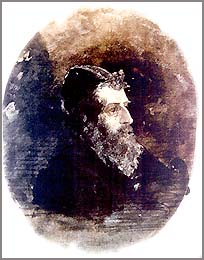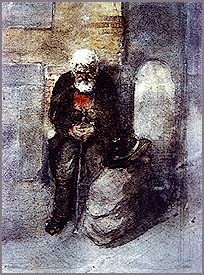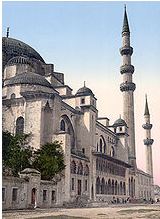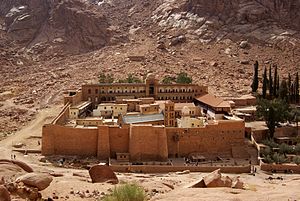SOURCE: Slugger O'Toole
by Gerry Lynch
Monasteries are very quiet places indeed. Garrulous as I am beyond the normal Irish capacity for such things, I am not someone obviously identifiable as a great lover of silence. At the Community of the Resurrection, even here in the heart of West Yorkshire’s network of densely populated post-industrial valleys, the daytime silence between the offices can be intense. The stillness is broken only by the occasional fall of well-shod feet along the corridor or the distant call of an ambulance siren carried on the breeze.
 |
| Viktor Hartmann’s Samuel Goldenberg. |
Jewish klezmer bands were a familiar feature of the Bohemia of Mahler’s youth. In the week after Holocaust Memorial Day, there is no need for explanation why they are no longer a feature of life in the 21st Century Czech Republic.
That thought brings another piece of music into my mind, one of the tone portraits from the Pictures of an Exhibition of that mad, drunk, Russian genius, Modest Mussorgsky – the dialogue between two Polish Jews. One is the fat and well-clad merchant, Samuel Goldenberg, represented in Ravel’s orchestration by pompously dismissive strings in baritone. The other is the old beggar Schmuÿle, by the side of the road begging with his cane, annoyingly insistent in thin, high pitched notes, swiftly tongued on muted trumpet.

|
| Viktor Hartmann’s Schmuÿle |
The rhythms drift into my mind as I read of the Ottoman conquest of Constantinople in Diarmaid MacCulloch’s magisterial History of Christianity. The fall of Constantinople marked the end of another world now long lost, the final destruction of the Roman state after 2000 years, and the end of the link between patriarch and emperor, which had dominated Eastern Christianity for a millennium. There was butchery and barbarism aplenty on that fateful day in 1453, notably when the invading Ottoman troops burst into Haghia Sofia in the middle of matins. The city was sacked and looted, and many of the survivors were taken as slaves.
 |
| Sinan’s Süleymaniye Mosque, Istanbul. |
The contrast with what was happening at the other end of the Mediterranean at the same time, as the reconquest of Spain reached its climax, could not be starker. Jews who fled Iberia rather than face death or forced conversion formed another group instrumental to the vitality of the Ottoman capital. The highly skilled and educated Muslim population of Andalusia that fled along with them did much to fuel the golden era of the Ottoman Empire that would run for the following two centuries.
The curious life in death of the Byzantine Empire continued for another five centuries in Greek Istanbul. Many Greeks remained even after the horrors of the 1920s ‘exchange of populations’, protected by the new republican government in Ankara as surety against any ill treatment of the Turkish Muslims of Greek Thrace. The community’s final destruction came only in 1955, when Adnan Menderes’ democratically elected government surreptitiously sponsored a pogrom against Christians and Jews to deflect attention from a creaking economy.
Perhaps, in centuries to come, historians will look at the Istanbul Pogrom as the first act in the final destruction of the ancient Christian communities of much of the Middle East. The omens, at present, do not look good. We may now, tragically, be seeing the beginning of another lost world.
Over half of Iraq’s Christians have already left since the American invasion. In Arab Iraq, outside the self-governing Kurdish north, the proportion is much higher. Many of those Iraqi Christians fled to Syria, home to the one of the Arab World’s largest and hitherto most secure Christian communities. God alone knows what will happen to them when the dust settles on what looks like being a protracted conflict. The decades-long emigration of Christians from Egypt has now intensified, with tens of thousands leaving Egypt every month. Palestinian Christianity has also been decimated by emigration, with Western opinion seemingly only interested in apportioning blame to the Israelis or to Palestinian Muslims, according to political preference.
 |
| St. Catherine’s Monastery, Egyptian Sinai. |
The American government that invaded Iraq was the most ostentatiously conservative Christian US government in living memory. Its closest ally, Tony Blair, was by some margin the most religious British Prime Minister since Gladstone. The parallels with the Fourth Crusade’s sack of Constantinople in 1203, the inflection point from which the decline of the Byzantine Empire became terminal, are irresistible.
The dominant strand of American Protestantism is too obsessed with lending political support to the Jewish state to pay too much attention to the fate of Middle Eastern Christians. Here in Northern Ireland, another stronghold of conservative Protestantism, the impending death of Arab Christianity is barely registered. The Vatican is more engaged, as a significant minority of the Christians in question belong to Uniate churches in full communion with Rome. Nonetheless, the political capital the Vatican has expended on raising the plight of Middle Eastern Christians with, say, the governments and people of Britain and France pales in comparison with the energy expended fighting a losing battle with the same governments over same-sex marriage.
The silence that may soon hang over the ancient monasteries of the Sinai and the Upper Tigris Valley is not that created to aid contemplation, but that of total destruction. After almost 2,000 years, all that may be left of the most ancient Christian communities of all may be documents for future historians to chronicle.
